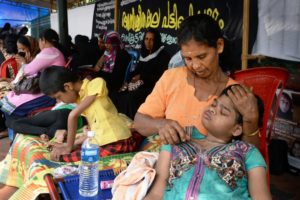Scars from the past: Endosulfan still a haunting story
With the slow pace of phasing out endosulfan from India, did we learn anything at all from Kasargod tragedy?

I
n the age of globalisation and soaring consumerism, industries have to match up with increased demands by increasing the production rates. Agriculture industry carries a huge burden of this ever increasing global demand for food and other products. Thus, to protect their crops from insects or pests, farmers as advised by experts and government, resort to pesticides for maximum utilization of their crop. Same happened in Kasargod- a district of Kerala, where farmers were using a particular insecticide named endosulfan for over 20 years of aerial spraying on cashew plantations, fruits, etc. Though it saved their crops, farmers and their families were left scared for the rest of their lives with its extremely harmful side effects such as congenital anomalies, delayed puberty, different forms of mental ailments in newborns, cancer and reproductive disorders etc.
Endosulfan is an insecticide and pesticide developed in early 1950s which is being used throughout the globe in the field of agriculture around the world to control insect pests including whiteflies, aphids, leafhoppers, colorado potato beetles, and worms. The legislature enacted Insecticide Act in 1968 to regulate the import, manufacture, sale, transport, distribution, and use of insecticides with a view to preventing risks to human beings or animals. In this Act, insecticides are being categorized in four labels according to their level of toxicity viz; red label, yellow label, blue label and green label which are mandatory labels employed on pesticide containers in India identifying the level of toxicity of the contained pesticide. Endosulfan comes under the purview of the yellow label which is a highly toxic category containing an oral lethal dose of 51-500 milligram per kilogram.
“Due to its acute toxicity and potential for bioaccumulation, a global ban on the manufacture and use of endosulfan was negotiated under the Stockholm Convention in April 2011. The World Health Organization estimated worldwide annual production to be about 9,000 metric tonnes in the early 1980s. From 1980 to 1989, worldwide consumption averaged 10,500 tonnes per year, and for the 1990s use increased to 12,800 tonnes per year.”
 More than 80 countries, including the European Union, Australia, New Zealand, several West African nations, the United States, Brazil, and Canada had already banned it because of its threats to human health and the environment with a global phasing out process. However, even after facing the worst side of endosulfan, India still has not phased out the insecticide from the country.
More than 80 countries, including the European Union, Australia, New Zealand, several West African nations, the United States, Brazil, and Canada had already banned it because of its threats to human health and the environment with a global phasing out process. However, even after facing the worst side of endosulfan, India still has not phased out the insecticide from the country.
Several national and international groups conducted health and toxicological studies between 1998 and 2002 had arrived at the conclusion that the abnormal health problems at Kasaragod district were due to the excessive spraying of endosulfan over a period of time. This was later followed with Kerala government imposing a complete ban on the use of the endosulfan which made other states and the central government notice it. The petition filed by Democratic Youth Federation of India in 2011 before a bench headed by Chief Justice S.H. Kapadia seeked a nationwide ban on the use of endosulfan or it’s any of form in the pesticide market of India.
Keeping scientific reports, medical opinions, and case studies in consideration, the Supreme Court of India banned endosulfan production, sale and use which led to congenital deformities and even deaths in the district of Kasargod. It was also revealed after the ban by the expert committee that 13.35 per cent of registered pesticides, including Endosulfan, posed serious health hazards, especially to the reproductive system, and could also lead to congenital deformities in India.
“The arial spraying of endosulfan on a population for many years led to the man-made disaster. The Relief and Remediation activities are not at all sincere and just an eyewash as response to the severe criticism from media and social groups. Their policy is now exposed when it is decided to continue the production of endosulfan to meet export commitments. The commitment to public and future generations shall have priority over any contractual commitments.” C.R. Neelakandan, Environmental Activist.
The Kerala state government then decided to stop endosulfan production at the Hindustan Insecticides Ltd (HIL).The Kerala State Pollution Control Board (KSPCB) had banned the use of endosulfan in the state. Despite side effects of this dangerous pesticide, HIL filed a petition in Supreme Court to produce endosulfan for export purposes. After considering the plea the Supreme Court on allowed the export of 1,090.596 tonnes of endosulfan to enable the manufacturers to meet their contractual obligations.
On 10, January 2017, directed to Kerala state government to give Rs 500 crore monetary compensation to over 5000 victims of the use of endosulfan pesticide. The SC bench headed by Chief Justice J S Khehar also asked the state to consider setting up a medical facility to provide life-long treatment to victims. The bench added that Kerala can also approach the Centre, state corporations for the monetary compensation amount. However, till 2018, many victims of endosulfan, as mentioned by C.R. Neelakandan, still await monetary compensation from the state.
Even though the reports of health issues started surfacing around 1990’s or even before that, it took the government, both at the state and the centre to realise to ban the insecticide not just in Kerala, but throughout India decades. Interestingly, even agrarian states like Punjab banned the sale of endosulfan as lately as January 2018 which speaks volumes about the pace at which India is keeping to its promise of phasing out endosulfan by 2017, way past its time, during the Stockholm Convention of 2011.
